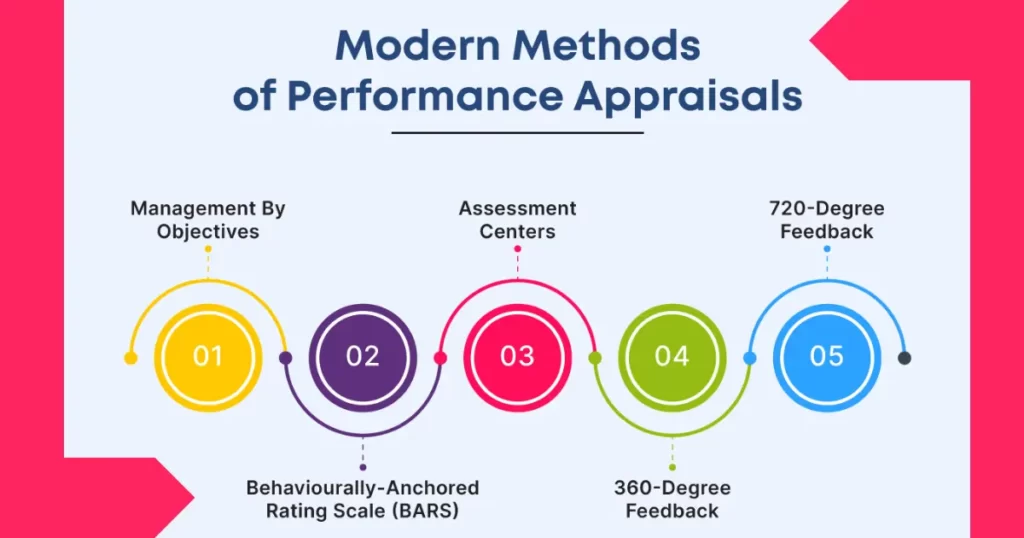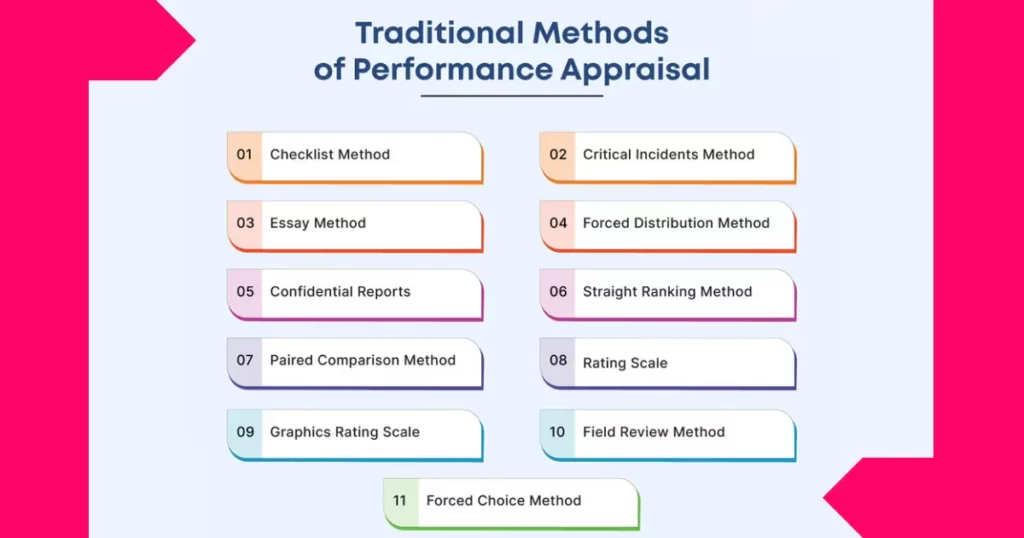Performance appraisal methods are the techniques and processes used by organizations to assess and evaluate the job performance of their employees.
So, these methods help in providing feedback, making compensation decisions, identifying training and development needs, and facilitating performance improvement.
There are various performance appraisal methods, each with its own strengths and weaknesses. But, there are two types of methods of performance appraisal in hrm described below.
Modern Methods of Performance Appraisal
Modern methods of performance appraisal have evolved to address the shortcomings of traditional methods and align with the changing nature of work and employee expectations.
These approaches emphasize continuous feedback, employee development, and a more holistic evaluation of performance. Here are some modern methods of performance appraisal.

360-Degree Feedback:
360-degree feedback gathers input from various sources, including peers, subordinates, managers, and even external stakeholders like customers.
Therefore, It provides a comprehensive view of an employee’s performance from multiple perspectives.
Continuous Performance Management:
This approach involves ongoing feedback and performance discussions throughout the year, rather than relying on annual or semi-annual reviews.
So, Managers and employees engage in regular one-on-one meetings to discuss progress, set goals, and address development needs.
Check-Ins:
Check-ins are short, frequent meetings between employees and managers to discuss performance, challenges, and goals.
Therefore, they allow for real-time feedback and adjustments, fostering agility and continuous improvement.
Goal Management:
Goal setting and tracking are integral to modern performance appraisal methods.
Employees and managers collaborate to set clear, specific, and measurable goals aligned with organizational objectives.
Objective Key Results (OKRs):
OKRs focus on setting high-level objectives and key results that measure progress toward those objectives.
Hence, they emphasize results and outcomes, promoting accountability and alignment.
Strengths-Based Assessments:
Instead of solely addressing weaknesses, modern methods encourage identifying and leveraging employees’ strengths.
This approach aims to maximize individual potential and contributions.
Behavioral Competency Frameworks:
Competency-based assessments focus on evaluating specific behaviors and skills required for a particular job.
So, They provide a clear and detailed framework for assessing performance.
Peer and Self-Assessment:
Employees have the opportunity to assess their own performance and provide input on their peers’ performance.
Hence, this promotes self-awareness and encourages employees to take ownership of their development.
Digital Performance Management Tools:
Technology plays a crucial role in modern performance appraisal.
Performance management software and digital platforms streamline processes, store performance-related data, and facilitate real-time feedback.
Continuous Learning and Development Plans:
Performance appraisal is closely linked to employee development.
But, Individual development plans are created to address skill gaps and provide training and growth opportunities.
Manager as Coach:
Managers take on a coaching role, providing guidance, mentoring, and support to help employees achieve their goals and maximize their potential.
Frequent Recognition and Rewards:
Recognition and rewards are integrated into the ongoing feedback process, motivating employees and reinforcing desired behaviors.
Data-Driven Insights:
Modern methods leverage data and analytics to assess performance trends, identify areas for improvement, and make informed decisions.
Feedback Culture:
Creating a culture of continuous feedback and open communication is a fundamental aspect of modern performance appraisal methods.
So, Organizations often tailor these modern methods to their specific needs and culture. Therefore, they aim to create a performance management process that is more agile, employee-centric, and conducive to fostering development and growth.
Traditional Methods of Performance Appraisal
Traditional methods of performance appraisal have been used by organizations for many years to assess and evaluate the job performance of their employees.
Hence, these methods tend to be structured, periodic, and often rely on standardized criteria. So, here are some common traditional methods of performance appraisal:

Graphic Rating Scales:
In this method, employees are evaluated based on a set of predefined traits or criteria.
Managers use a rating scale (e.g., 1 to 5) to assess employees on these criteria.
So, the scores are then summed to determine overall performance.
Behaviorally Anchored Rating Scales (BARS):
BARS combines elements of narrative and rating scales.
Specific, job-related behaviors are described for each performance level, providing more detailed feedback.
Critical Incident Method
Managers maintain records of specific incidents or events where employees excelled or faced challenges.
So, These incidents are discussed during performance reviews as concrete examples of performance.
Management by Objectives (MBO):
Employees and managers collaborate to set measurable objectives and goals.
Hence, Performance is evaluated based on the extent to which these objectives are achieved.
Ranking Method:
Employees are ranked from best to worst or vice versa based on their performance.
So, Forced ranking may be used to categorize employees into predetermined percentiles.
Narrative or Essay Evaluation:
Managers provide written narratives describing an employee’s strengths, weaknesses, achievements, and areas for improvement.
Therefore, This method offers more qualitative feedback.
Checklist Method:
A checklist of traits, behaviors, or skills is used to evaluate employee performance. So, Managers mark items on the checklist to assess performance.
Comparative Evaluation (Paired Comparison):
Employees are compared in pairs, and evaluators choose the stronger performer in each pair. Therefore, This method is used to rank employees relative to each other.
Forced Distribution:
Employees are categorized into predetermined performance groups (e.g., top performers, average performers, poor performers) based on a fixed distribution.
So, a specific percentage of employees falls into each category.
Self-Assessment:
Employees assess their own performance and discuss it with their managers. But, managers may use self-assessment as part of the appraisal process.
Weighted Checklist Method:
Similar to the checklist method, but each item on the checklist is assigned a weight or importance score. So, Scores are totaled to determine an overall rating.
Annual Reviews:
Performance appraisals are conducted annually or semi-annually, with employees and managers meeting to discuss performance over a set period.
Traditional performance appraisal methods have faced criticism for being infrequent, overly structured, and sometimes leading to bias or subjectivity in evaluations.
Many organizations are transitioning to more modern performance management approaches that emphasize continuous feedback, goal alignment, and employee development.
Effective performance appraisal methods Impact on Employee Development and Organizational Success
- Effective performance appraisal methods facilitate employee growth, enhancing their skills and competencies.
- By aligning individual and organizational goals, these methods drive employee engagement and motivation.
- Performance appraisal methods enable data-driven HR decisions, such as promotions, succession planning, and compensation adjustments.
- Organizations that employ effective performance appraisal methods tend to perform better, as their workforce is aligned with strategic objectives.
Conclusion
Performance management methods are not one-size-fits-all. Organizations must choose methods that align with their culture, goals, and resources.
So, by implementing appropriate methods, organizations can foster excellence, drive innovation, and achieve sustainable success in today’s competitive business landscape.
Performance management is not just a process; it’s a dynamic driver of growth and progress.
Read More:
0 Comments